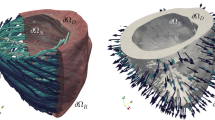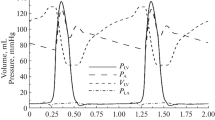Abstract
Finite elasticity theory combined with finite element analysis provides the framework for analysing ventricular mechanics during the filling phase of the cardiac cycle, when cardiac cells are not actively contracting. The orthotropic properties of the passive tissue are described here by a “pole–zero” constitutive law, whose parameters are derived in part from a model of the underlying distributions of collagen fibres. These distributions are based on our observations of the fibrous-sheet laminar architecture of myocardial tissue. We illustrate the use of high order (cubic Hermite) basis functions in solving the Galerkin finite element stress equilibrium equations based on this orthotropic constitutive law and for incorporating the observed regional distributions of fibre and sheet orientations. Pressure–volume relations and 3D principal strains predicted by the model are compared with experimental observations. A model of active tissue properties, based on isolated muscle experiments, is also introduced in order to predict transmural distributions of 3D principal strains at the end of the contraction phase of the cardiac cycle. We end by offering a critique of the current model of ventricular mechanics and propose new challenges for future modellers.
Similar content being viewed by others
References
R.J. Atkin and N. Fox, An Introduction to the Theory of Elasticity. Longman, London (1980).
J.B. Caulfield and T.K. Borg, The collagen network of the heart. Lab. Invest. 40(3) (1979) 364–372.
K.D. Costa, P.J. Hunter, J.M. Rogers, J.M. Guccione, L.K. Waldman and A.D. McCulloch, A three-dimensional finite element method for large elastic deformations of ventricular myocardium: Part I-Cylindrical and spherical polar coordinates. ASME J. Biomech. Engrg. 118(4) (1996) 452–463.
K.D. Costa, P.J. Hunter, J.M. Rogers, J.M. Guccione, L.K. Waldman and A.D. McCulloch, A three-dimensional finite element method for large elastic deformations of ventricular myocardium: Part II-Prolate spherical coordinates. ASME J. Biomech. Engrg. 118(4) (1996) 464–472.
K.D. Costa, K. May-Newman, D. Farr, W.G. O'Dell, A.D. McCulloch and J.H. Omens, Three-dimensional residual strain in midanterior canine left ventricle. Amer. J. Physiol. 273 (1997) H1968-H1976.
L.L. Demer and F.C.P. Yin, Passive biaxial mechanical properties of isolated canine myocardium. J. Physiol. London 339 (1983) 615–630.
S. Dokos, B.H. Smaill, A.A. Young and I.J. Le Grice, Anisotropic shear properties of passive ventricular myocardium. Amer. J. Physiol. (2001) (submitted).
S. Dokos, A.A. Young, B.H. Smaill and I.J. Le Grice, A triaxial-measurement shear-test device for soft biological tissues. ASME J. Biomech. Engrg. (2001) (in press).
P. Gould, D. Ghista, L. Brombolich and I. Mirsky, In vivo stresses in the human left ventricular wall: Analysis accounting for the irregular 3-dimensional geometry and comparison with idealised geometry analyses. J. Biomech. 5 (1972) 521–539.
J.D. Humphrey, R.K. Strumpf and F.C.P. Yin, Determination of a constitutive relation for passive myocardium: II. Parameter estimation. ASME J. Biomech. Engrg. 112 (1990) 340–346.
P.J. Hunter, A.D. McCulloch and H.E.D.J. ter Keurs, Modelling the mechanical properties of cardiac muscle. Prog. Biophys. Molec. Biol. 69 (1998) 289–331.
P.J. Hunter, M.P. Nash and G.B. Sands, Computational electromechanics of the heart. In: A.V. Panfilov and A.V. Holden (eds), Computational Biology of the Heart. Wiley, West Sussex, England (1997) Chapter 12, pp. 345–407.
J.M. Huyghe, T. Arts, D.H. van Campen and R.S. Reneman, Porous medium finite element model of the beating left ventricle. Amer. J. Physiol. 262 (Heart Circ. Physiol. 31) (1992) H1256-H1267.
J.M. Huyghe, D.H. van Campen, T. Arts and R.M. Heethaar, A two-phase finite element model of the diastolic left ventricle. J. Biomech. 24(7) (1991) 527–538.
R.F. Janz and A.F. Grimm, Finite-element model for the mechanical behaviour of the left ventricle: Prediction of deformation in the potassium-arrested rat heart. Circ. Res. 30 (1972) 244–252.
R.F. Janz and A.F. Grimm, Deformation of the diastolic left ventricle. I. Nonlinear elastic effects. Biophys. J. 13 (1973) 689–704.
A.M. Katz, Physiology of the Heart, 2nd ed. Raven Press, New York (1992).
P. Kohl, P. Hunter and D. Noble, Stretch-induced changes in heart rate and rhythm: Clinical observations, experiments and mathematical models. Prog. Biophys. Molec. Biol. 71(1) (1999) 91–138.
I.J. Le Grice, B.H. Smaill, L.Z. Chai, S.G. Edgar, J.B. Gavin and P.J. Hunter, Laminar structure of the heart: Ventricular myocyte arrangement and connective tissue architecture in the dog. Amer. J. Physiol. 269(38) (1995) H571-H582.
I.J. Le Grice, Y. Takayama and J.W. Covell, Transverse shear along myocardial cleavage planes provides a mechanism for normal systolic wall thickening. Circ. Res. 77 (1995) 182–193.
D.A. MacKenna, J.H. Omens and J.W. Covell, Left ventricular perimysial collagen fibers uncoil rather than stretch during diastolic filling. Basic Res. Cardiol. 91(2) (1996) 111–122.
D.A. MacKenna, J.H. Omens, A.D. McCulloch and J.W. Covell, Contributions of collagen matrix to passive left ventricular mechanics in isolated rat hearts. Amer. J. Physiol. 266 (1994) H1007-H1018.
L.E. Malvern, Introduction to the Mechanics of a Continuous Medium. Prentice-Hall, Englewood Cliffs, NJ (1969).
A.D. McCulloch, Cardiac biomechanics. In: J.D. Bronzino (ed.), The Biomedical Engineering Handbook. CRC Press, Boca Raton, FL (1995) Chapter 31, pp. 418–439.
A.D. McCulloch and J.H. Omens, Non-homogeneous analysis of three-dimensional transmural finite deformation in canine ventricular myocardium. J. Biomech. 24(7) (1991) 539–548.
I. Mirsky, Ventricular and arterial wall stresses based on large deformation analyses. Biophys. J. 13(11) (1973) 1141–1159.
M.P. Nash, Mechanics and material properties of the heart using an anatomically accurate mathematical model. PhD Thesis, The University of Auckland, New Zealand (1998).
P.M.F. Nielsen, I.J. Le Grice, B.H. Smaill and P.J. Hunter, Mathematical model of geometry and fibrous structure of the heart. Amer. J. Physiol. 260 (Heart Circ. Physiol. 29) (1991) H1365-H1378.
J.T. Oden, Finite Elements of Nonlinear Continua. McGraw-Hill, New York (1972).
J.H. Omens, K.D. May and A.D. McCulloch, Transmural distribution of three-dimensional strain in the isolated arrested canine left ventricle. Am. J. Physiol. 261 (Heart Circ. Physiol. 30) (1991) H918-H928.
T.F. Robinson, M.A. Geraci, E.H. Sonnenblick and S.M. Factor, Coiled perimysial fibers of papillary muscle in rat heart: Morphology, distribution and changes in configuration. Circ. Res. 63 (1988) 577–592.
E.K. Rodriguez, A. Hoger and A.D. McCulloch, Stress-dependent finite growth in soft elastic tissues. J. Biomech. 27(4) (1994) 455–467.
B.H. Smaill and P.J. Hunter, Structure and function of the diastolic heart: Material properties of passive myocardium. In: L. Glass, P.J. Hunter and A.D. McCulloch (eds), Theory of Heart: Biomechanics, Biophysics, and Nonlinear Dynamics of Cardiac Function. Springer, New York (1991) pp. 1–29.
D.D. Streeter, Jr., H.M. Spotnitz, D.P. Patel, J. Ross, Jr. and E.H. Sonnenblick, Fibre orientation in the canine left ventricle during diastole and systole. Circ. Res. 24 (1969) 339–347.
Y. Takayama, I.J. Le Grice, J.W. Holmes and J.W. Covell, Effects of chordal uncoupling on deformation in the papillary muscle. FASEB J. 8(5) (1994) A591.
J.V. Tyberg and E.R. Smith, Ventricular diastole and the role of the pericardium. Herz 15(6) (1990) 354–361.
G.S. Tyson, Jr., G.W. Maier, C.O. Olsen, J.W. Davis and J.S. Rankin, Pericardial influences on ventricular filling in the conscious dog: An analysis based on pericardial pressure. Circ. Res. 54 (1984) 173–184.
T.P. Usyk, R. Mazhari and A.D. McCulloch, Effect of laminar orthotropic myofiber architecture on regional stress and strain in the canine left ventricle. J. Elasticity 61 (2000) 143–164.
F.J. Villarreal, W.Y.W. Lew, L.K. Waldman and J.W. Covell, Transmural myocardial deformation in the ischemic canine left ventricle. Circ. Res. 68(2) (1991) 368–381.
W.M. Vogel, C.S. Apstein, L.L. Briggs, W.H. Gaasch and J. Ahn, Acute alterations in left ventricular diastolic chamber stiffness: Role of the erectile effect of coronary arterial pressure and flow in normal and damaged hearts. Circ. Res. 51(4) (1982) 465–478.
L.K. Waldman, Y.C. Fung and J.W. Covell, Transmural myocardial deformation in the canine left ventricle: Normal in vivo three-dimensional finite strains. Circ. Res. 57(1) (1985) 152–163.
L.K. Waldman, D. Nossan, F. Villareal and J.W. Covell, Relation between transmural deformation and local myofiber direction in the canine left ventricle. Circ. Res. 63 (1988) 550–562.
R.H. Woods, A few applications of a physical theorem to membranes in the human body in a state of tension. J. Anat. Physiol. 26 (1892) 362–370.
M. Yang and L.A. Taber, The possible role of poroelasticity in the apparent viscoelastic behaviour of passive cardiac muscle. J. Biomech. 24(7) (1991) 587–597.
F.C.P. Yin, Ventricular wall stress. Circ. Res. 49(4) (1981) 829–842.
F.C.P. Yin, R.K. Strumpf, P.H. Chew and S.L. Zeger, Quantification of the mechanical properties of noncontracting canine myocardium under simultaneous biaxial loading. J. Biomech. 20 (1987) 577–589.
A.A. Young, I.J. Le Grice, M.A. Young and B.H. Smaill, Extended confocal microscopy of myocardial laminae and collagen network. J. Microsc. 192(2) (1998) 139–150.
O.C. Zienkiewicz and R.L. Taylor, The Finite ElementMethod. I. Basic Formulation and Linear Problems, 4th ed. McGraw-Hill, Berkshire, UK (1994).
Author information
Authors and Affiliations
Rights and permissions
About this article
Cite this article
Nash, M.P., Hunter, P.J. Computational Mechanics of the Heart. Journal of Elasticity 61, 113–141 (2000). https://doi.org/10.1023/A:1011084330767
Issue Date:
DOI: https://doi.org/10.1023/A:1011084330767




